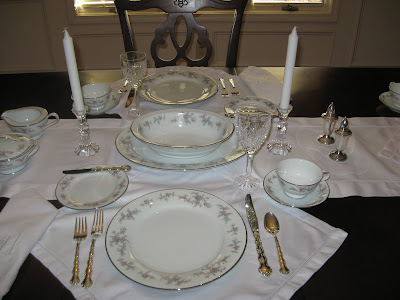
Inspiration for today's tablescape came from these vintage valentine postcards. Knowing how I loved violets, my husband gave me these postcards while we were dating. Wasn't that sweet?
 My love for collecting violet china began with spotting this tea set in an antique booth in the Charleston Market. It caught my eye because violets were my sorority flower. Did you know that the Victorians attributed modesty and faithfulness to violets?
My love for collecting violet china began with spotting this tea set in an antique booth in the Charleston Market. It caught my eye because violets were my sorority flower. Did you know that the Victorians attributed modesty and faithfulness to violets? Here is another violet teapot that I was given. It has the same pattern of the violets bound with a white ribbon as are on the dessert plates and cups and saucers. All of these pieces were found at different times and are stamped with different manufacturers. To the left of the tea pot is a violet tea strainer I was given. I love loose tea and like having these as not all tea pots have built in strainers. Two tea pots makes it possible to offer two varieties of tea. Would you prefer Harney & Sons' Valentine's Blend (with chocolate and rose petals) or their Indian Spice?
Here is another violet teapot that I was given. It has the same pattern of the violets bound with a white ribbon as are on the dessert plates and cups and saucers. All of these pieces were found at different times and are stamped with different manufacturers. To the left of the tea pot is a violet tea strainer I was given. I love loose tea and like having these as not all tea pots have built in strainers. Two tea pots makes it possible to offer two varieties of tea. Would you prefer Harney & Sons' Valentine's Blend (with chocolate and rose petals) or their Indian Spice? The lace tablecloth reminded me of doilies pasted on homemade Valentines.
The lace tablecloth reminded me of doilies pasted on homemade Valentines. The dessert plates looked a little lost on their own. I tried my formal dinner plates underneath them, but the platinum trim clashed with the gold trim on the violet plates. I pulled out some antique violet handkerchiefs and draped them over the dinner plates.
The dessert plates looked a little lost on their own. I tried my formal dinner plates underneath them, but the platinum trim clashed with the gold trim on the violet plates. I pulled out some antique violet handkerchiefs and draped them over the dinner plates.
The different handkerchiefs add a certain charm, don't they?

I added a Waterford Araglin Traditions iced beverage glass for those who might like some iced water. I had to substitute wine glasses at two of the place settings (because of the Great Thanksgiving Smash-up of 2008), but since this is a mix-and-match tablescape, I think it works.

The violet cake plate was a birthday gift several years ago from the great-aunt whose china I inherited (You can see the tablescape I created with that china here.). I think it makes a great pedestal for the vintage Valentines.


For more tabletop inspiration, be sure to visit our hostess Susan.


















